Performances of halide scintillators for the dosimetry based on gamma-ray spectrometry for environmental monitoring systems
IF 2.6
3区 工程技术
Q1 NUCLEAR SCIENCE & TECHNOLOGY
引用次数: 0
Abstract
High pressure ion chambers (HPIC) and NaI(Tl) scintillation detectors are widely used to monitor the ambient dose equivalent rate H∗(10) within and around the Korean nuclear facilities. However, HPIC cannot provide spectrometric information and NaI(Tl) detector is limited in identifying nuclides, such as 131I, 134Cs, and 137Cs, released from nuclear facilities owing to its insufficient energy resolution. This study employed four halide scintillators – LaBr3(Ce), CeBr3, and SrI2(Eu) – to measure the ambient dose equivalent rate and detect gamma nuclides from measured energy spectrum. First, the pulse–shaping time in the signal processing unit was optimized for each scintillator. Second, energy resolution and counting efficiency were estimated for 137Cs and 60Co. Finally, an irradiation test was performed to estimate the dose rate. Based on these results, LaBr3(Ce) and NaI(Tl) were selected as in situ gamma spectrometry system for measuring environmental radiation, and field experiments were conducted near the Fukushima Daiichi nuclear power plant to measure the dose rate.
卤化物闪烁体在环境监测系统伽马射线分光计基础上的剂量测定性能
高压离子室(HPIC)和 NaI(Tl)闪烁探测器被广泛用于监测韩国核设施内部和周围的环境剂量当量率 H*(10)。然而,HPIC 无法提供光谱信息,而 NaI(Tl)探测器由于能量分辨率不足,在识别核设施释放的 I、Cs 和 Cs 等核素方面受到限制。这项研究采用了四种卤化物闪烁体--LaBr(Ce)、CeBr 和 SrI(Eu)--来测量环境剂量当量率,并从测量的能谱中探测伽马核素。首先,针对每种闪烁体优化了信号处理装置中的脉冲整形时间。其次,对铯和钴的能量分辨率和计数效率进行了估算。最后,进行了辐照试验,以估算剂量率。根据这些结果,我们选择了 LaBr(Ce)和 NaI(Tl)作为测量环境辐射的原位伽马能谱系统,并在福岛第一核电站附近进行了实地实验,以测量剂量率。
本文章由计算机程序翻译,如有差异,请以英文原文为准。
求助全文
约1分钟内获得全文
求助全文
来源期刊

Nuclear Engineering and Technology
工程技术-核科学技术
CiteScore
4.80
自引率
7.40%
发文量
431
审稿时长
3.5 months
期刊介绍:
Nuclear Engineering and Technology (NET), an international journal of the Korean Nuclear Society (KNS), publishes peer-reviewed papers on original research, ideas and developments in all areas of the field of nuclear science and technology. NET bimonthly publishes original articles, reviews, and technical notes. The journal is listed in the Science Citation Index Expanded (SCIE) of Thomson Reuters.
NET covers all fields for peaceful utilization of nuclear energy and radiation as follows:
1) Reactor Physics
2) Thermal Hydraulics
3) Nuclear Safety
4) Nuclear I&C
5) Nuclear Physics, Fusion, and Laser Technology
6) Nuclear Fuel Cycle and Radioactive Waste Management
7) Nuclear Fuel and Reactor Materials
8) Radiation Application
9) Radiation Protection
10) Nuclear Structural Analysis and Plant Management & Maintenance
11) Nuclear Policy, Economics, and Human Resource Development
 求助内容:
求助内容: 应助结果提醒方式:
应助结果提醒方式:


